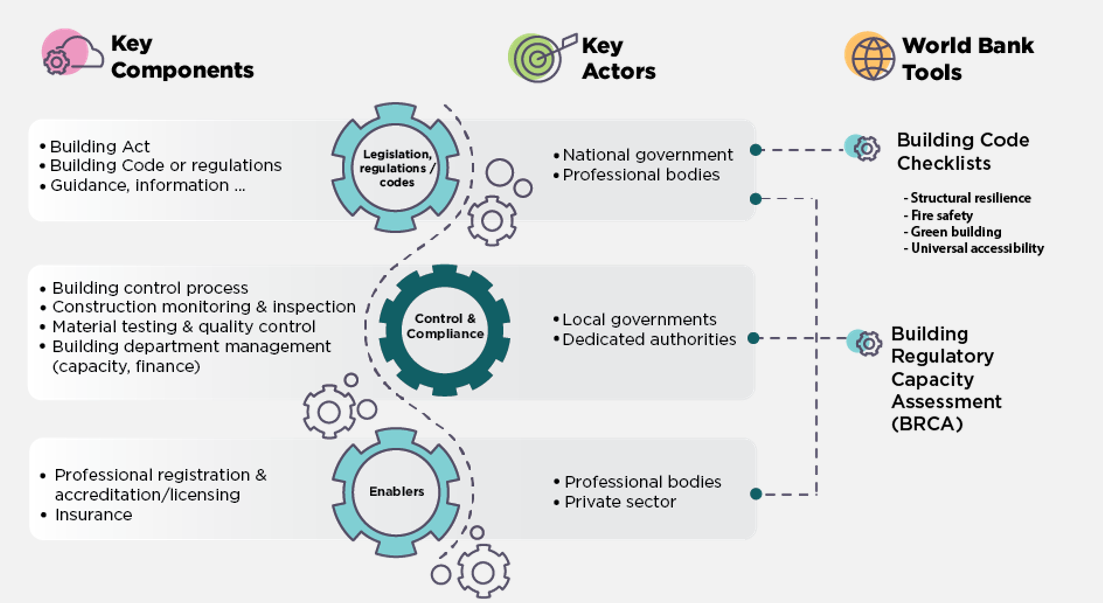Building Regulation for Resilience promotes the enhancement of building regulatory frameworks, building control process, and implementation capacity to foster safer, greener, healthier, and more inclusive built environments at country, state or city scale. Building Regulation for Resilience provides technical assistance to facilitate governments’ incremental efforts in the areas of regulatory, policy and institutional reforms and creation of an enabling environment for better compliance. Learn more in this brief.
Buildings are integral to societies and economies: they provide essential spaces for people to live and work and house critical services necessary to keep communities, businesses and governments in operation. They also reflect cultural values and serve as a primary defense against natural hazards and climate impacts, if they are built with resilience in mind.
Why do building regulations matter?
Building regulations play a vital role in enhancing the safety and resilience of built environments while reducing potential damages and losses for people, buildings and the services that they house. Beyond this, they play an important role to ensure that buildings are universally accessibility as well as facilitate strategies to both adapt to and mitigate the impacts of climate change through lower carbon, energy and resource efficient design and construction practices. Effective Building Regulatory Frameworks are essential to achieve these goals, as they:
- Improve the safety, resilience and affordability of the built environment.
- Reduce damages and losses to the built environment from disaster events as well as from chronic risks (e.g., building failures due to poor quality design and construction).
- Promote green and sustainable design and construction practices to both mitigate and adapt to the impacts of climate change while providing healthier and more comfortable environments for people.
- Facilitate universal access for people of all ages and abilities.
What services does GFDRR provide?
The GFDRR's Building Regulation for Resilience supports governments with legal, regulatory, policy and institutional reforms, starting with diagnostic assessments to understand baselines, key challenges and opportunities. It provides technical assistance through: (i) regulatory reviews and recommendations, (ii) global and regional knowledge products, and (iii) capacity building activities for better code compliance targeting building professionals in both public and private sectors, to achieve safer, greener, and more inclusive built environments.
Discover more about GFDRR's work on Building Regulation for Resilience here.
A Building Regulatory Framework is a set of laws, regulatory documents, compliance mechanisms, education and training requirements, product testing and certification processes, professional qualifications, and licensing schemes that support resilient, green, and inclusive built environments. The following figure illustrates key components of a building regulatory framework, key actors, and tools offered by the World Bank and GFDRR to identify entry points for potential reforms.

Highlights
Services
Technical support and advisory services include assessments to understand baselines and challenges, generating recommendations to improve building regulatory frameworks. Methodologies and tools developed by GFDRR's Building Regulations for Resilience are tailored to support governments in specific country contexts by assessing building regulatory systems and identifying gaps and opportunities for strategic risk reduction investments and policy actions. The main tools are:
1. Building Regulatory Capacity Assessment (BRCA): A tool for a comprehensive review of the building regulatory frameworks and implementation capacity. The methodology facilitates the evaluation of regulatory advancements, identification of gaps and opportunities to improve specific elements of the regulatory frameworks. This assessment serves as a resource for specifying interventions across various regulatory initiatives in cities and countries.
2. Building Code Checklists: A set of tools to conduct an in-depth technical review of building code contents focusing on the four key topics listed below, underpinned by comparative analyses of a wide range of building codes from around the world. This includes: structural resilience, fire safety, green building, and universal accessibility.
Global knowledge and capacity building are enablers of enhanced building regulatory frameworks. Sharing the experience of other countries and global good practices can help countries improve their building regulatory frameworks to leapfrog some steps and undertake relevant reforms more efficiently. Capacity building to support effective implementation of building regulatory framework in each country requires continuous investment to ensure effective compliance in the design and construction industry.
Analytical Reports
Global and regional studies present reviews and comparative analyses of building regulatory frameworks within a region or with a focus on specific building regulation topics by analyzing selected countries. These reports present unique datasets of building regulations that illustrate snapshots of building regulatory frameworks in different parts of the world and share key insights for countries to identify potential entry points for each country’s reform journey. The latest study focused on Sub-Saharan African region and reviewed the current building regulations in the region and how well they enable a safer, more resilient, inclusive and sustainable built environment, and concluded with practical recommendations.
Country level reports are produced as summaries of the analytical works conducted by Building Regulation for Resilience, mainly by applying the diagnostic tool, the Building Regulatory Capacity Assessment (BRCA). Each country study assesses building regulatory framework and implementation arrangements and capacity, and identifies priority recommendations to facilitate governments’ decision making process to support building regulatory reforms. The following reports and related materials communicate the findings from assessments conducted at country level.

Watch the Building Regulation for Resilience videos playlist on YouTube







































